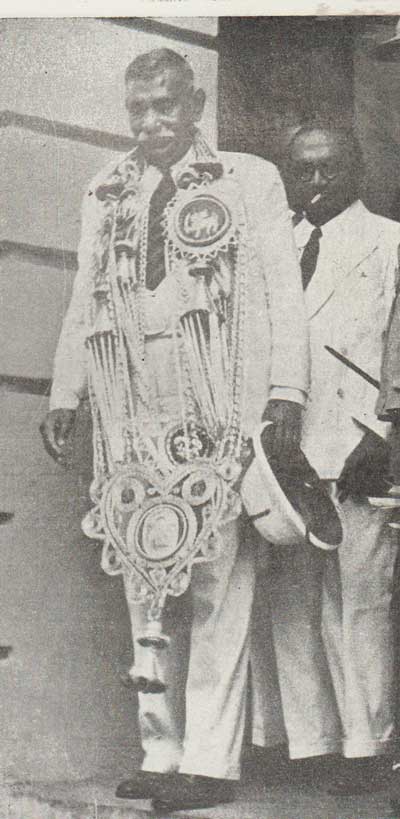Thursday Jan 22, 2026
Thursday Jan 22, 2026
Saturday, 15 August 2015 00:00 - - {{hitsCtrl.values.hits}}

D.S. Senanayake after winning the Mirigama seat at the 1947 election
It’s just two more days for the general election 2015. Propaganda meetings are taboo from today. House-to-house canvassing may continue on a low key. At every election, there are a few questions that are discussed as the election date gets nearer. ‘Who will win?’ is the most obvious. ‘Can our man do it?’ ‘Who will form the government?’ ‘What are the chances of our party?’ –These are among other ‘most often’ asked questions.
In the early days the accent was on individual candidates. After political parties came on the scene and candidates started contesting under the party banner, ‘who will win?’ became a ‘dual-purpose’ question. With the introduction of ‘manape’ along with the Executive Presidency, it was the party or the coalition that was talked about more than the individual. With MPs being elected on the Electoral District basis, the concept of ‘our man’ got diluted. The voters could no longer distinctly identify their MP. 
It was from 1947 onwards with the first election under the Soulbury Constitution that the party system came into prominence. Nine political parties nominated candidates at the 1947 general election to elect members for the first Parliament set up under the Westminster model. In addition to 180 coming forward from parties, 181 contested as independents. Ninety six MPs were to be elected from 89 constituencies for the 101-member Parliament. (Balance six were nominated by the Governor). The contestants came forward for each constituency which meant they had to get to know their voters intimately.
The UNP which had been formed just a little over a year earlier (on 4 June 1946) fielded the highest number (98) of candidates. The meeting presided over by D.S. Senanayake, the Leader of the State Council and Minister of Agriculture and Lands was attended by five ministers and 25 State Council members.
The LSSP, the party with the longest and chequered history dating back to the Suriyamal Movement formed as a protest of the annual Poppy Day, and was formally launched in December 1935, put forward 28 candidates under the leadership of Dr. N.M. Perera. Third in the list was the Communist Party (19 candidates) followed by the Bolshevik Leninist Party (10) – both formed by breakaway groups who were active in the Suriyamal Movement. The other five parties had less than ten candidates each.
An interesting feature was that not a single party had enough elected members to form the government on its own. The UNP with 42 seats had the highest number and when invited by the Governor to form the government, managed to muter the support of the All-Ceylon Tamil Congress (seven MPs) under G.G. Ponnambalam, and a few other MPs. UNP leader D S Senanayake became Prime Minister. Dr N M Perera was elected Leader of the Opposition since the LSSP had secured 10 seats – the second in the list.
The second general election in 1952 saw the newly formed Sri Lanka Freedom Party (SLFP) by S.W.R.D. Bandaranaike (Leader of the House and Minister in the first Parliament) who left the UNP a few months before the election, contesting.
The formation of coalitions to contest elections began with the initiative taken by SLFP leader Bandaranaike in 1956. While SLFP was the lead party, veteran politicians Philip Gunawardena (leader of Viplavakari Sama Samaja Party) and W. Dahanayake (Bhasha Permuna) joined to form the Mahajana Eksath Peramuna (MEP) to contest the 1956 general election.
Bandaranaike also succeeded in forming no-contest pacts with the LSSP and the CP thus avoiding a contest among opposition candidates in the different electorates. In joining forces their intent was to defeat the UNP, considered the “common enemy”.
Though civil society organisations were not known as it is today, the ‘Pancha Balavegaya’ – five forces comprising the Sangha, teachers, ayurvedic physicians, farmers and labourers – supported Bandaranaike and the MEP. Of these, the Eksath Bhikshu Peramuna played a prominent role. The final result was a victory for the MEP and Bandaranaike becoming prime minister.
Thereafter the pendulum started swinging and the government was formed either by a coalition led by the UNP or the SLFP. Often the UNP contested as a single party and formed coalitions later to form the government.
From 1947 onwards the UNP always contested under the Elephant symbol. With the formation of alliances by the SLFP to contest the elections, the party symbol, ‘Hand’ has been dropped. The Betel Leaf has been the favoured symbol since the formation of the People’s Alliance (1994) and later the United People’s Liberation Front (UPLF) with the SLFP as the main party.